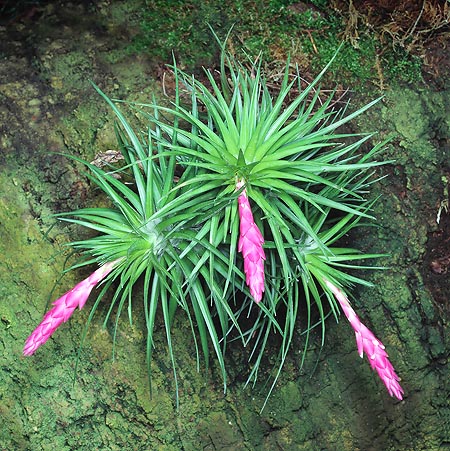Family : Bromeliaceae

Text © Pietro Puccio

English translation by Mario Beltramini

Robust and easy to till, also indoor © Giuseppe Mazza
The Tillandsia tenuifolia L. (1753) is native to the Caribbean and tropical South America (Argentina, Bolivia, Brazil, Cuba, Dominican Republic, French Guyana, Guyana, Haiti, Jamaica, Paraguay, Peru, Puerto Rico, Surinam, Venezuela and Windward Islands), where it grows as epiphytic on the trees and the rocks.
The genus is honoured to the Swedish physician and botanist Elias Erici Til-Landz (1640-1693); the name of the species is the combination of the Latin words, “tenuis” = thin, and “folium” = leaf, with obvious signification.
Common names: “narrowleaf airplant” (English); “tillandsia à petites feuilles” (French); “bromélia de moita”, “cravo-do-mato”, “erva da fortuna” (Portuguese).
Evergreen herbaceous plant, monocarpic (bearing fruit only one time during its existence), acaulescent, epiphytic or lythophytic, somewhat variable, with a rosette of several rigid leaves, sharp, of a greyish green colour, up to about 12 cm long and 4-7 mm broad, which, time passing, forms thick tufts with a slightly hanging appearance.
The floral scape develops at the centre of the rosette, more or less as long as the leaves, surrounded by bracts which, in the lower part are green or rose-coloured with small grey scales, whilst in the terminal part they are pink to red. The floral scape end with an inflorescence formed by a simple spike with oval bracts, of the same colour as the terminal ones of the floral scape, from which come out the flowers, long about 2 cm, and placed spirally, with white or blue petals. It reproduces by seed and, easily, by vegetative way, through the new plants which come out between the leaves from axillary gemmae.
Very diffused plant, appreciated for its strength and facility of cultivation, it can be cultivated in open air in the tropical, subtropical zones and even in the warm temperate ones, as it resists to temperatures around -5/-6°C, in full sun or filtered sunny light, on trees and rocks. In summer, in the dry climate zones, nebulisations with preferably non-calcareous water, in order to avoid anti-aestethic dots on the leaves, are to be effected, in winter same are to stopped. In the places where the climate does not allow the cultivation in open air all the year round, it can be anchored on a piece of bark or of branch, in order to place it under shelter in winter in a very luminous and aerated space, effecting at times, and only during warm and luminous days, short nebulisations in the morning in such a way to give time to the plant to dry up, in particular if the air of the room where the plant is placed is too dry.
Synonyms: Tillandsia pulchella Hook. (1825).
→ For general notions about BROMELIACEAE please click here.
